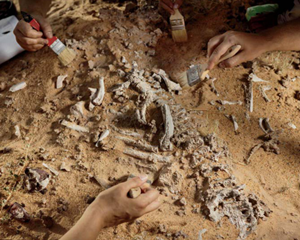The idea of three people drowning in the Sahara seems ludicrous until you consider that the Sahara hasn't always been a desert.
三個人在撒哈拉溺死的想法似乎很可笑,但仔細(xì)想想,撒哈拉并非一直都是沙漠。
In fact, it transforms from desert to lush savanna about every 21,000 years.
事實(shí)上,那里大概每隔21000年就會從沙漠變成蒼翠的稀樹大草原。
A quirk in Earth's planetary mechanics periodically causes its axis to tilt slightly, increasing the amount of radiation directed to the Northern Hemisphere, which in turn pulls Africa's seasonal rains northward.
地球的行星力學(xué)有個怪異之處,會過期性地造成地軸微微傾斜,使得直射北半球的輻射量增加,這又讓非洲的季節(jié)雨向北移動。
For millions of years, this cycle of monsoon shifts has created numerous wet periods in the Sahara.
數(shù)百萬年來,這種季風(fēng)偏移的循環(huán)在撒哈拉產(chǎn)生很多次的豐水期。
The most recent one began at the end of the last ice age, roughly 12,000 years ago, and persisted until about 4,500 years ago.
最近的一次是始于上一個冰河時(shí)代末期,大約12000年前,持續(xù)到大約4500年前。
Technology has helped scholars see what this Green Sahara looked like.
拜科技之賜,學(xué)者現(xiàn)在已經(jīng)能夠了解這種“綠色撒哈拉”的模樣。
Satellites have identified ancient riverbeds and the shorelines of lakes, including the original perimeter of Lake Chad, which at its peak was bigger than all the North American Great Lakes combined.
衛(wèi)星已辨認(rèn)出古代的河床和湖岸線,包括乍得湖的原始邊緣,它在高峰期時(shí)比北美洲的五大湖全部加起來還要大。
But even more obvious clues about the Green Sahara have been staring scholars in the face.
不過綠色撒哈拉更明顯的線索一直擺在學(xué)者面前。
Thousands of engravings and paintings discovered on rock formations throughout the Sahara document thriving hunter-gatherer communities.
在撒哈拉各地的巖層,發(fā)現(xiàn)了數(shù)千處雕刻和繪畫,記錄著興盛的狩獵采集者群落。
The artists portrayed figures wearing elaborate headdresses and throwing spears and shooting arrows.
藝術(shù)家描繪的人物戴著繁復(fù)的頭飾,投擲長矛、射出飛箭。
But their main subjects were the animals they saw, including hippos, giraffes, elephants, rhinos, and antelope -- species now more closely associated with wetter parts of Africa.
但他們主要的題材是眼中所見的動物,包括河馬、長頸鹿、大象、犀牛和羚羊,如今這些物種主要分布在非洲比較多雨的地區(qū)。
Despite such vivid depictions, we know very little about these people.
盡管有這么生動的描繪,我們對那些人卻知之甚少。
During the 20th century, a handful of significant archaeological sites were found in the Sahara.
20世紀(jì),人們在撒哈拉發(fā)現(xiàn)了一些重要的考古遺址,
Excavations yielded samplings of pottery and stone tools -- isolated glimpses of Green Sahara cultures.
發(fā)掘出的少量陶器和石器,這些個別的發(fā)現(xiàn)讓人得以一窺綠色撒哈拉的不同文化。
But for the most part, the desert's intense radiation, high winds, and shifting sands have scattered, buried, and scoured away much of the evidence of their existence.
但整體來說,沙漠的強(qiáng)烈輻射、強(qiáng)風(fēng)和流沙,早已讓這些文化存在的多數(shù)證據(jù)四散各處、遭到掩埋和侵蝕。
So it was practically a miracle when Paul Sereno stumbled upon Gobero.
因此,保羅·塞雷諾意外發(fā)現(xiàn)格伯托簡直是個奇跡。
He's an unlikely scientist to find a human burial ground, as his primary subjects lived millions of years before humans.
他這樣的科學(xué)家其實(shí)不太可能發(fā)現(xiàn)人類墓地遺址,因?yàn)樗闹饕芯繉ο蟮纳鏁r(shí)期比人類早了好幾百萬年。

Since the early 1990s, the University of Chicago paleontologist and National Geographic Explorer has made headlines for his discoveries of new dinosaur species in the Sahara,
從20世紀(jì)90年代初期至今,這位芝加哥大學(xué)古生物學(xué)家、國家地理探險(xiǎn)家好幾次登上新聞頭條,因?yàn)樗谌龉l(fā)現(xiàn)了一些新種恐龍,
including Afrovenator, a fast-running meat-eater; Suchomimus, a creature the length of a school bus, with a crocodile-like head; and Jobaria, a 70-foot-long plant-eater with an elongated neck.
其中包括非洲獵龍,一種跑得飛快的食肉恐龍;以及似鱷龍,體長像一輛校車、頭部像鱷類的恐龍;還有約巴龍,體長70英尺的食草恐龍,有著細(xì)長的頸部。
In 2000, Sereno was looking for more of their kind as he led a scouting expedition in the Ténéré.
2000年,塞雷諾帶領(lǐng)一個搜索遠(yuǎn)征隊(duì)去泰內(nèi)雷沙漠,想要尋找更多的新種恐龍。
The team spent one morning driving in a convoy of Land Rovers near a rocky ridgeline. Periodically, they'd stop to search on foot for fossils.
有一天,團(tuán)隊(duì)的路虎車隊(duì)在一條巖石棱脊附近開了一上午的車,每隔一陣子就停下來,以步行方式尋找化石。
Just as the convoy was about to return to camp, Mike Hettwer, the expedition's photographer, wandered toward three small dunes.
就在車隊(duì)準(zhǔn)備回營地時(shí),遠(yuǎn)征隊(duì)的攝影師麥克·黑特維緩步走向三座小沙丘。
He found them covered with human bones, potsherds, arrowheads, and other stone artifacts. "It was all there just lying on the sand," he told me, "everywhere you looked."
他發(fā)現(xiàn)那里滿地都是人類骨頭、陶器碎片、箭頭和其他古代石器。“全都躺在那里的沙子上,”他對我說,“放眼望去都是。”
Bido Dindine, one of the expedition's Tuareg guides, said local camel herders referred to the area as Gobero.
遠(yuǎn)征隊(duì)的一位圖阿雷格部族向?qū)М叾唷ざ〉蟽?nèi)說,當(dāng)?shù)仞B(yǎng)駱駝的人稱這里為格伯托。
There were also lots of animal bones. Paleontologists study modern species to understand dinosaur physiology, and Sereno has a near-encyclopedic memory for animal skeletons.
這里還有大量的動物骨頭。古生物學(xué)家會研究現(xiàn)代的物種,以便了解恐龍的生理學(xué),而塞雷諾對動物骸骨的記憶有如百科全書。
He quickly recognized the bones of hippos, giraffes, fish, crocodiles, and turtles. "All the animals we find in the Serengeti were there," he said.
他很快就認(rèn)出河馬、長頸鹿、魚類、鱷魚和龜類的骨頭。“我們在塞倫蓋蒂地區(qū)發(fā)現(xiàn)的所有動物,這里都有。”他說。
Next to the dunes they found a dry lake bed, which helped explain the large concentration of aquatic animals.
他們在沙丘旁邊發(fā)現(xiàn)一個干涸的湖床,有助于解釋大量聚集的水生動物。
"There was so much to take in," Sereno said. "It was overwhelming."
“有好多事要理解,”塞雷諾說,“信息量太大了。”
They made a quick survey, estimating that the area contained upwards of 200 burials.
他們很快檢視一番,粗估這個地區(qū)有超過200座墳?zāi)埂?/div>
Eventually, Sereno came to understand that the three dunes were protected by a doughnut-like rim of rhizoconcretions, a type of rock formed around the roots of reeds and other plants.
最后塞雷諾了解到,這三座沙丘被一圈甜甜圈狀的“根結(jié)核”保護(hù),這是一種巖石,會出現(xiàn)在蘆葦和其他植物的根部周圍。
This created a protective crust that kept the dunes intact. When the rhizoconcretions finally started to break apart, the skeletons had begun to emerge.
這會產(chǎn)生一種保護(hù)殼,讓沙丘保持完整。等到根結(jié)核終于開始破裂,骸骨就漸漸暴露出來。
There were half-buried skulls, hands reaching out of the sand, ribs scattered.
有半埋著的頭骨、從沙里伸出來的手,肋骨散落一地。
"The rhizoconcretions are why those burials survived thousands of years," Sereno said, noting the seasonal Harmattan winds, which carry Saharan dust across West Africa to the Atlantic. "Any exposed bones won't last long."
“根結(jié)核是這些墓葬能保存數(shù)千年的原因。”塞雷諾說。他指出,季節(jié)性的哈麥丹風(fēng)會帶著撒哈拉的塵土越過西非抵達(dá)大西洋。“只要骨頭暴露出來,都撐不了太久。”
He showed me a photo of a skull from the 2000 trip and another photo of it in the same spot five years later. Much of the bone had been ground away -- literally sandblasted.
他給我看了2000年那趟行程拍攝的一張頭骨照片,以及五年后在同一地點(diǎn)拍攝的另一張照片。骨頭大部分都已經(jīng)磨蝕掉,其實(shí)就等同于被噴砂研磨掉了。
"That's what the desert does," Sereno said.
“那是沙漠做的好事。”塞雷諾說。












